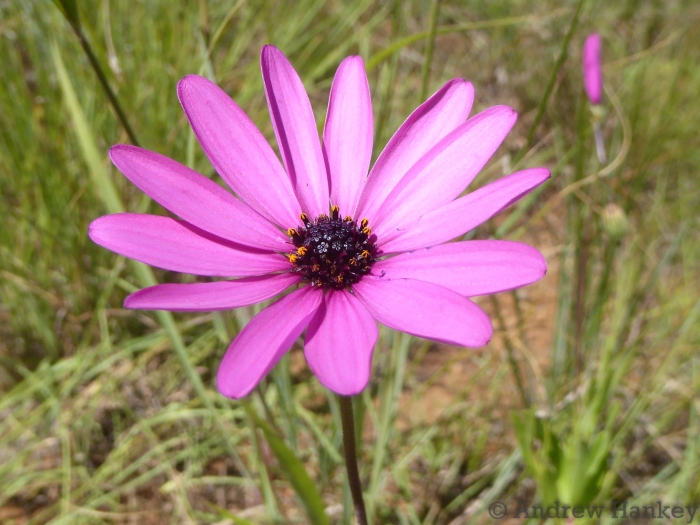Trailing African Daisy
(Dimorphotheca spectabilis)
Trailing African Daisy (Dimorphotheca spectabilis)
/
/

© Andrew Hankey
CC BY-SA 4.0
Image By:
© Andrew Hankey
Recorded By:
Copyright:
CC BY-SA 4.0
Copyright Notice:
Photo by: © Andrew Hankey | License Type: CC BY-SA 4.0 | License URL: http://creativecommons.org/licenses/by-sa/4.0/ | Uploader: andrew_hankey | Publisher: iNaturalist |















Estimated Native Range
Summary
Dimorphotheca spectabilis, commonly known as Trailing African Daisy or Star of the Veldt, is a perennial herb native to the open, sunny areas of Southern Africa, including grasslands and along roadsides. It is a fast-growing plant that typically reaches a height of 0.5-1 feet (0.15-0.3 meters) and spreads 1.5-2 feet (0.5-0.6 meters). The plant forms a low, spreading mound covered in lance-shaped leaves and produces daisy-like flowers with white, yellow, or orange petals surrounding a dark center. These vibrant, showy flowers bloom profusely in the spring and summer, attracting pollinators such as bees and butterflies.
Trailing African Daisy is valued for its drought tolerance and vibrant floral display, making it an excellent choice for rock gardens, borders, and ground cover in warm climates. It is also used in hanging baskets and as a spiller in container plantings. This plant thrives in full sun and prefers well-drained sandy or loamy soils. It is relatively low-maintenance, requiring minimal water once established. However, gardeners should be cautious as Dimorphotheca spectabilis can become invasive in some regions outside its native range, outcompeting local flora. It is advisable to consult local regulations before planting to prevent ecological disruption.CC BY-SA 4.0
Trailing African Daisy is valued for its drought tolerance and vibrant floral display, making it an excellent choice for rock gardens, borders, and ground cover in warm climates. It is also used in hanging baskets and as a spiller in container plantings. This plant thrives in full sun and prefers well-drained sandy or loamy soils. It is relatively low-maintenance, requiring minimal water once established. However, gardeners should be cautious as Dimorphotheca spectabilis can become invasive in some regions outside its native range, outcompeting local flora. It is advisable to consult local regulations before planting to prevent ecological disruption.CC BY-SA 4.0
Plant Description
- Plant Type: Herb, Subshrub
- Height: 0.5-1 feet
- Width: 1.5-2 feet
- Growth Rate: Rapid
- Flower Color: White, Yellow, Orange
- Flowering Season: Spring, Summer
- Leaf Retention:
Growth Requirements
- Sun: Full Sun
- Water: Low
- Drainage: Medium, Fast
Common Uses
Border Plant, Drought Tolerant, Low Maintenance, Potted Plant
Natural Habitat
Native to open, sunny areas of Southern Africa, including grasslands and along roadsides
Other Names
Common Names: Star of the Veldt, Gazania Daisy
Scientific Names: , Dimorphotheca spectabilis, Castalis spectabilis, Dimorphotheca ecklonis,
GBIF Accepted Name: